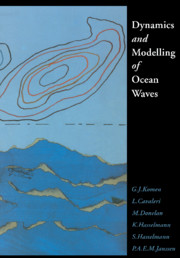Book contents
- Frontmatter
- Contents
- Contributors
- Preface
- Chapter I Basics
- Chapter II The physical description of wave evolution
- Chapter III Numerical modelling of wave evolution
- Chapter IV Applications to wave hindcasting and forecasting
- Chapter V Global satellite wave measurements
- Chapter VI Wave data assimilation and inverse modelling
- Chapter VII Summary and outlook
- Members of the WAM group
- Affiliations and addresses of contributors
- Notation and abbreviations
- References
- Index
Chapter II - The physical description of wave evolution
Published online by Cambridge University Press: 22 January 2010
- Frontmatter
- Contents
- Contributors
- Preface
- Chapter I Basics
- Chapter II The physical description of wave evolution
- Chapter III Numerical modelling of wave evolution
- Chapter IV Applications to wave hindcasting and forecasting
- Chapter V Global satellite wave measurements
- Chapter VI Wave data assimilation and inverse modelling
- Chapter VII Summary and outlook
- Members of the WAM group
- Affiliations and addresses of contributors
- Notation and abbreviations
- References
- Index
Summary
Introduction
Any numerical model of a physical process necessarily represents that process by a set of mathematical relations that approximate the underlying physical laws. The level of approximation is determined principally by two factors: (1) knowledge of the physical processes; (2) computational limitations. The latter forces one to view the problem of the evolution of waves on an oceanic scale as a statistical one. The process of global wave evolution encompasses scales as large as the basin (107 metres) involving ocean currents, topography and wind variations, and as small as the smallest waves (10-3 metres) that modify the wind stress – it could be argued that even smaller scales associated with turbulent interfacial couplings play a role in the process. The statistical approach essentially treats the bottom 4/5 of this physical range of ten orders of magnitude as though those scales respond to well-defined physical laws imposed at the nodes of a numerical grid of typical size of one degree of latitude. The task of defining appropriate mathematical expressions that reflect the essential physics of the process is one of synthesizing the results of theoretical calculations and observational programs. As discussed in chapter I, the mathematical framework is based on a statistical description of waves having a range of scales of about one metre to one kilometre. These waves evolve in response to an action balance equation in which the ‘physics’ is embodied in a set of source functions. In this chapter, we first discuss the source functions individually and then examine the observational evidence of spectral characteristics and wave growth in fetch-limited and in shallow water situations and directional adjustment to turning winds.
- Type
- Chapter
- Information
- Dynamics and Modelling of Ocean Waves , pp. 69 - 202Publisher: Cambridge University PressPrint publication year: 1994

